Deck 6: Chemical Reactivity and Mechanisms
Question
Question
Question
Question
Question
Question
Question
Question
Question
Question
Question
Question
Question
Question
Question
Question
Question
Question
Question
Question
Question
Question
Question
Question
Question
Question
Question
Question
Question
Question
Question
Question
Question
Question
Question
Question
Question
Question
Question
Question
Question
Question
Question
Question
Question
Question
Question
Question
Question
Question
Question
Question
Question
Question
Question
Question
Question
Question
Question
Question
Question
Question
Question
Question
Question
Question
Question
Question
Question
Question
Question
Question
Question
Question
Question
Question
Question
Question
Question
Question

Unlock Deck
Sign up to unlock the cards in this deck!
Unlock Deck
Unlock Deck
1/110
Play
Full screen (f)
Deck 6: Chemical Reactivity and Mechanisms
1
Predict the sign of S of the following reaction. 
A) positive
B) negative
C) no change

A) positive
B) negative
C) no change
positive
2
Predict the sign of S of the following reaction. 
A) positive
B) negative
C) no change

A) positive
B) negative
C) no change
negative
3
Which of the following is the enthalpy change of the following reaction under standard conditions? 
A) -8 kJ/mol
B) +8 kJ/mol
C) -506 kJ/mol
D) +63 kJ/mol

A) -8 kJ/mol
B) +8 kJ/mol
C) -506 kJ/mol
D) +63 kJ/mol
-8 kJ/mol
4
You are working in a research laboratory and have developed a new reagent that cleaves C-H bonds homolytically. Unfortunately, this reagent can achieve only one of the transformations shown below. In light of bond dissociation energies, which transformation is most likely to be achieved?
A)
B)
C)
D)
A)

B)

C)

D)


Unlock Deck
Unlock for access to all 110 flashcards in this deck.
Unlock Deck
k this deck
5
What type of bond cleavage does the following reaction involve? 


Unlock Deck
Unlock for access to all 110 flashcards in this deck.
Unlock Deck
k this deck
6
Predict the sign of S of the following reaction. 


Unlock Deck
Unlock for access to all 110 flashcards in this deck.
Unlock Deck
k this deck
7
Estimate the enthalpy change of the following reaction under standard conditions. 


Unlock Deck
Unlock for access to all 110 flashcards in this deck.
Unlock Deck
k this deck
8
Later in the course, we will compare the halogenation of differently substituted carbons, comparing reactions like the ones below. Which of the following statements is true about reactions A and B? 
A) Both reactions have a positive heat of reaction ( Ho)
B) Neither reaction has a positive heat of reaction ( Ho)
C) Only reaction A has a positive heat of reaction ( Ho)
D) Only reaction B has a positive heat of reaction ( Ho)

A) Both reactions have a positive heat of reaction ( Ho)
B) Neither reaction has a positive heat of reaction ( Ho)
C) Only reaction A has a positive heat of reaction ( Ho)
D) Only reaction B has a positive heat of reaction ( Ho)

Unlock Deck
Unlock for access to all 110 flashcards in this deck.
Unlock Deck
k this deck
9
Estimate the enthalpy change of the following reaction under standard conditions. 


Unlock Deck
Unlock for access to all 110 flashcards in this deck.
Unlock Deck
k this deck
10
Predict the sign of G for an endothermic reaction with an increase in entropy.
A) positive
B) negative
C) no change
D) cannot predict without additional information
A) positive
B) negative
C) no change
D) cannot predict without additional information

Unlock Deck
Unlock for access to all 110 flashcards in this deck.
Unlock Deck
k this deck
11
Predict the sign of S of the following reaction. 


Unlock Deck
Unlock for access to all 110 flashcards in this deck.
Unlock Deck
k this deck
12
Of following reactions, which one(s) would you expect to have a negative S?
A)
B)
C)
D)
A)

B)

C)

D)


Unlock Deck
Unlock for access to all 110 flashcards in this deck.
Unlock Deck
k this deck
13
Later in the course, we will compare the halogenation of differently substituted carbons, comparing reactions like the ones below. Which of the following reactions has a more exothermic heat of reaction ( Ho)? 
A) Reaction A has a more exothermic heat of reaction ( Ho)
B) Reaction B has a more exothermic heat of reaction ( Ho)
C) Both reactions have the same heat of reaction ( Ho)

A) Reaction A has a more exothermic heat of reaction ( Ho)
B) Reaction B has a more exothermic heat of reaction ( Ho)
C) Both reactions have the same heat of reaction ( Ho)

Unlock Deck
Unlock for access to all 110 flashcards in this deck.
Unlock Deck
k this deck
14
Which of the following would you expect to have the most negative S?
A)
B)
C)
D)
A)

B)

C)

D)


Unlock Deck
Unlock for access to all 110 flashcards in this deck.
Unlock Deck
k this deck
15
Why is the entropy change negative for ring closures?
A) Closing a ring results in fewer molecules.
B) Closing a ring results in more molecules.
C) Closing a ring releases energy.
D) Closing a ring restricts the rotation around individual carbon-carbon bonds.
A) Closing a ring results in fewer molecules.
B) Closing a ring results in more molecules.
C) Closing a ring releases energy.
D) Closing a ring restricts the rotation around individual carbon-carbon bonds.

Unlock Deck
Unlock for access to all 110 flashcards in this deck.
Unlock Deck
k this deck
16
Predict the sign of G for an exothermic reaction with an increase in entropy.
A) positive
B) negative
C) no change
D) cannot predict without additional information
A) positive
B) negative
C) no change
D) cannot predict without additional information

Unlock Deck
Unlock for access to all 110 flashcards in this deck.
Unlock Deck
k this deck
17
Which of the following is the enthalpy change of the following reaction under standard conditions? 
A) -8 kJ/mol
B) +8 kJ/mol
C) +222 kJ/mol
D) +79 kJ/mol

A) -8 kJ/mol
B) +8 kJ/mol
C) +222 kJ/mol
D) +79 kJ/mol

Unlock Deck
Unlock for access to all 110 flashcards in this deck.
Unlock Deck
k this deck
18
What type of bond cleavage does the following reaction involve? 
A) homolytic
B) heterolytic

A) homolytic
B) heterolytic

Unlock Deck
Unlock for access to all 110 flashcards in this deck.
Unlock Deck
k this deck
19
Predict the sign of S of the following reaction. 
A) positive
B) negative
C) no change

A) positive
B) negative
C) no change

Unlock Deck
Unlock for access to all 110 flashcards in this deck.
Unlock Deck
k this deck
20
Estimate the enthalpy change of the following reaction under standard conditions. 


Unlock Deck
Unlock for access to all 110 flashcards in this deck.
Unlock Deck
k this deck
21
Based on the following energy diagram, is the reaction exothermic or endothermic? 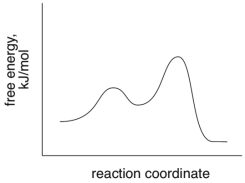


Unlock Deck
Unlock for access to all 110 flashcards in this deck.
Unlock Deck
k this deck
22
What is the energy of activation for the following reaction? 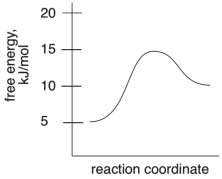


Unlock Deck
Unlock for access to all 110 flashcards in this deck.
Unlock Deck
k this deck
23
Does a reaction with a H of 20 kJ/mol and a S of 10 J/mol K at 298 K favor reactants or products?

Unlock Deck
Unlock for access to all 110 flashcards in this deck.
Unlock Deck
k this deck
24
Given the following rate law, what is the order of the reaction with respect to MeI? 


Unlock Deck
Unlock for access to all 110 flashcards in this deck.
Unlock Deck
k this deck
25
Predict the sign of G for an exothermic reaction with a decrease in entropy.
A) positive
B) negative
C) no change
D) cannot predict without additional information
A) positive
B) negative
C) no change
D) cannot predict without additional information

Unlock Deck
Unlock for access to all 110 flashcards in this deck.
Unlock Deck
k this deck
26
Does a reaction with a Keq = 10 favor reactants or products?

Unlock Deck
Unlock for access to all 110 flashcards in this deck.
Unlock Deck
k this deck
27
Based on the following energy diagram, is the reaction exothermic or endothermic? 


Unlock Deck
Unlock for access to all 110 flashcards in this deck.
Unlock Deck
k this deck
28
Given the following rate law, what is the order of the reaction with respect to sodium cyanide? 


Unlock Deck
Unlock for access to all 110 flashcards in this deck.
Unlock Deck
k this deck
29
Does a reaction with a negative G favor reactants or products?

Unlock Deck
Unlock for access to all 110 flashcards in this deck.
Unlock Deck
k this deck
30
Predict the sign of G for an endothermic reaction with a decrease in entropy.
A) positive
B) negative
C) no change
D) cannot predict without additional information
A) positive
B) negative
C) no change
D) cannot predict without additional information

Unlock Deck
Unlock for access to all 110 flashcards in this deck.
Unlock Deck
k this deck
31
What is the effect of a catalyst on a reaction?
A) It increases the rate.
B) It decreases the entropy.
C) It changes the equilibrium.
D) It makes the products more stable.
A) It increases the rate.
B) It decreases the entropy.
C) It changes the equilibrium.
D) It makes the products more stable.

Unlock Deck
Unlock for access to all 110 flashcards in this deck.
Unlock Deck
k this deck
32
Given the following rate law, what is the order of the reaction with respect to tert-butyl iodide? 


Unlock Deck
Unlock for access to all 110 flashcards in this deck.
Unlock Deck
k this deck
33
Which of the following describes the effect of a catalyst on a reaction?
A) It lowers the free energy of the products.
B) It makes the reactants less stable.
C) It changes the equilibrium constant.
D) It lowers the energy of activation.
A) It lowers the free energy of the products.
B) It makes the reactants less stable.
C) It changes the equilibrium constant.
D) It lowers the energy of activation.

Unlock Deck
Unlock for access to all 110 flashcards in this deck.
Unlock Deck
k this deck
34
Does a reaction with a positive S and a negative H favor reactants or products?

Unlock Deck
Unlock for access to all 110 flashcards in this deck.
Unlock Deck
k this deck
35
Which of the following is an energy diagram for a three-step reaction?
A)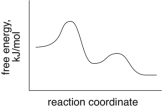
B)
C)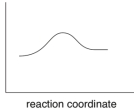
D)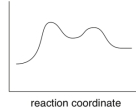
A)

B)

C)

D)


Unlock Deck
Unlock for access to all 110 flashcards in this deck.
Unlock Deck
k this deck
36
Does a reaction with a H of 14 kJ/mol and a S of 150 J/molK at 298 K favor reactants or products?

Unlock Deck
Unlock for access to all 110 flashcards in this deck.
Unlock Deck
k this deck
37
Does a reaction with a positive G favor reactants or products?

Unlock Deck
Unlock for access to all 110 flashcards in this deck.
Unlock Deck
k this deck
38
Does a reaction with a positive S and a positive H favor reactants or products?

Unlock Deck
Unlock for access to all 110 flashcards in this deck.
Unlock Deck
k this deck
39
What is the energy of activation for the following reaction? 


Unlock Deck
Unlock for access to all 110 flashcards in this deck.
Unlock Deck
k this deck
40
Which of the following is an energy diagram for a two-step reaction?
A)
B)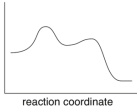
C)
D)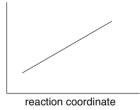
A)

B)

C)

D)


Unlock Deck
Unlock for access to all 110 flashcards in this deck.
Unlock Deck
k this deck
41
Identify the electrophilic site in the following molecule. 


Unlock Deck
Unlock for access to all 110 flashcards in this deck.
Unlock Deck
k this deck
42
Identify the electrophilic site in the following molecule. 


Unlock Deck
Unlock for access to all 110 flashcards in this deck.
Unlock Deck
k this deck
43
Which of the following energy diagrams shows a concerted endothermic reaction?
A)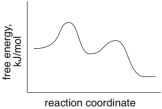
B)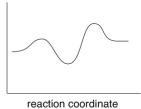
C)
D)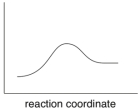
A)

B)

C)

D)


Unlock Deck
Unlock for access to all 110 flashcards in this deck.
Unlock Deck
k this deck
44
Which of the following energy diagrams shows the reaction with the smallest energy of activation?
A)
B)
C)
D)
A)

B)

C)

D)


Unlock Deck
Unlock for access to all 110 flashcards in this deck.
Unlock Deck
k this deck
45
Draw an energy diagram for a concerted exothermic reaction.

Unlock Deck
Unlock for access to all 110 flashcards in this deck.
Unlock Deck
k this deck
46
Identify the nucleophilic site in the following molecule. 


Unlock Deck
Unlock for access to all 110 flashcards in this deck.
Unlock Deck
k this deck
47
Identify the nucleophilic centers in the following molecule. 


Unlock Deck
Unlock for access to all 110 flashcards in this deck.
Unlock Deck
k this deck
48
Identify the electrophilic site in the following molecule. 
A) H
B) C of carbonyl
C) C other than carbonyl
D) O of carbonyl

A) H
B) C of carbonyl
C) C other than carbonyl
D) O of carbonyl

Unlock Deck
Unlock for access to all 110 flashcards in this deck.
Unlock Deck
k this deck
49
What is an intermediate?
A) A local maximum on the energy diagram.
B) A point on the reaction pathway that has a discrete lifetime.
C) A point half-way between the starting materials and products.
D) The highest energy compound on an energy diagram.
A) A local maximum on the energy diagram.
B) A point on the reaction pathway that has a discrete lifetime.
C) A point half-way between the starting materials and products.
D) The highest energy compound on an energy diagram.

Unlock Deck
Unlock for access to all 110 flashcards in this deck.
Unlock Deck
k this deck
50
Draw an energy diagram for a three-step reaction.

Unlock Deck
Unlock for access to all 110 flashcards in this deck.
Unlock Deck
k this deck
51
Identify the nucleophilic site(s) in the following molecule. 


Unlock Deck
Unlock for access to all 110 flashcards in this deck.
Unlock Deck
k this deck
52
Identify the nucleophilic atom in the following molecule. 
A) P
B) C
C) H
D) Me

A) P
B) C
C) H
D) Me

Unlock Deck
Unlock for access to all 110 flashcards in this deck.
Unlock Deck
k this deck
53
What is a transition state?
A) An isolable intermediate in a reaction.
B) The starting materials of the reaction.
C) A local maximum on the energy diagram.
D) A low-energy point between the starting materials and the product.
A) An isolable intermediate in a reaction.
B) The starting materials of the reaction.
C) A local maximum on the energy diagram.
D) A low-energy point between the starting materials and the product.

Unlock Deck
Unlock for access to all 110 flashcards in this deck.
Unlock Deck
k this deck
54
Identify the electrophilic site in the following molecule. 


Unlock Deck
Unlock for access to all 110 flashcards in this deck.
Unlock Deck
k this deck
55
Identify the electrophilic site in the following molecule. 
A) C
B) O
C) B
D) No electrophilic site

A) C
B) O
C) B
D) No electrophilic site

Unlock Deck
Unlock for access to all 110 flashcards in this deck.
Unlock Deck
k this deck
56
Which of the following energy diagrams is of a reaction with one transition state?
A)
B)
C)
D)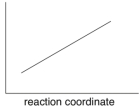
A)

B)

C)

D)


Unlock Deck
Unlock for access to all 110 flashcards in this deck.
Unlock Deck
k this deck
57
Which of the following cannot be a nucleophile?
A)
B)
C)
D)
A)

B)

C)

D)


Unlock Deck
Unlock for access to all 110 flashcards in this deck.
Unlock Deck
k this deck
58
Draw an energy diagram for an endothermic reaction with two steps.

Unlock Deck
Unlock for access to all 110 flashcards in this deck.
Unlock Deck
k this deck
59
Which of the following energy diagrams is of a reaction with one intermediate?
A)
B)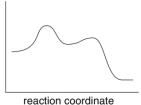
C)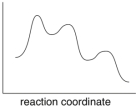
D)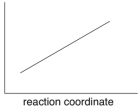
A)

B)

C)

D)


Unlock Deck
Unlock for access to all 110 flashcards in this deck.
Unlock Deck
k this deck
60
Identify the nucleophilic site in the following molecule. 


Unlock Deck
Unlock for access to all 110 flashcards in this deck.
Unlock Deck
k this deck
61
Which of the following mechanistic steps represents the loss of a leaving group?
A)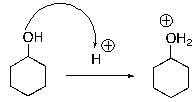
B)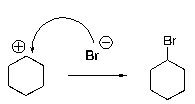
C)
D)
A)

B)

C)

D)


Unlock Deck
Unlock for access to all 110 flashcards in this deck.
Unlock Deck
k this deck
62
Which of the following cannot be an electrophile?
A)
B)
C)
D)
A)

B)

C)

D)


Unlock Deck
Unlock for access to all 110 flashcards in this deck.
Unlock Deck
k this deck
63
Melphalan, a drug used in chemotherapy, reacts with itself in the body before binding with its target, as illustrated in the mechanism below. Which two patterns of arrow pushing are seen in this reaction? 


Unlock Deck
Unlock for access to all 110 flashcards in this deck.
Unlock Deck
k this deck
64
The following reaction has three mechanistic steps. Identify the pattern of arrow pushing steps in each step. 


Unlock Deck
Unlock for access to all 110 flashcards in this deck.
Unlock Deck
k this deck
65
Identify the sequence of curved arrows (electron movement) in the steps of the following reaction. 
A) Proton transfer, proton transfer
B) Proton transfer, loss of leaving group
C) Nucleophilic attack, proton transfer
D) Proton transfer, nucleophilic attack

A) Proton transfer, proton transfer
B) Proton transfer, loss of leaving group
C) Nucleophilic attack, proton transfer
D) Proton transfer, nucleophilic attack

Unlock Deck
Unlock for access to all 110 flashcards in this deck.
Unlock Deck
k this deck
66
Which of the following is the most stable cation?
A)
B)
C)
D)
A)

B)

C)

D)


Unlock Deck
Unlock for access to all 110 flashcards in this deck.
Unlock Deck
k this deck
67
For the following reaction step, indicate which pattern of arrow pushing it represents. 
A) Proton transfer
B) Loss of leaving group
C) Nucleophilic attack
D) Rearrangement

A) Proton transfer
B) Loss of leaving group
C) Nucleophilic attack
D) Rearrangement

Unlock Deck
Unlock for access to all 110 flashcards in this deck.
Unlock Deck
k this deck
68
Which of the following is hydride?
A) H+
B) H
C) H−
D) H2
A) H+
B) H
C) H−
D) H2

Unlock Deck
Unlock for access to all 110 flashcards in this deck.
Unlock Deck
k this deck
69
For the following reaction step, indicate which pattern of arrow pushing it represents. 


Unlock Deck
Unlock for access to all 110 flashcards in this deck.
Unlock Deck
k this deck
70
For the following reaction step, indicate which pattern of arrow pushing it represents. 
A) Proton transfer
B) Loss of leaving group
C) Nucleophilic attack
D) Rearrangement

A) Proton transfer
B) Loss of leaving group
C) Nucleophilic attack
D) Rearrangement

Unlock Deck
Unlock for access to all 110 flashcards in this deck.
Unlock Deck
k this deck
71
For the following reaction step, indicate which pattern of arrow pushing it represents. 
A) Proton transfer
B) Loss of leaving group
C) Nucleophilic attack
D) Rearrangement

A) Proton transfer
B) Loss of leaving group
C) Nucleophilic attack
D) Rearrangement

Unlock Deck
Unlock for access to all 110 flashcards in this deck.
Unlock Deck
k this deck
72
Melphalan, a drug used in chemotherapy, reacts with itself before binding with its target in the body, as illustrated below. Draw in the curved arrows that account for this transformation. 


Unlock Deck
Unlock for access to all 110 flashcards in this deck.
Unlock Deck
k this deck
73
What is wrong with the following mechanism? 
A) There is no leaving group, so there should be no arrows.
B) The arrow should be removing a proton from the H2O group.
C) An arrow is also needed to indicate the loss of the leaving group.
D) The arrow indicating the formation of the C-Br bond (nucleophilic attack) should start at the bromide anion.

A) There is no leaving group, so there should be no arrows.
B) The arrow should be removing a proton from the H2O group.
C) An arrow is also needed to indicate the loss of the leaving group.
D) The arrow indicating the formation of the C-Br bond (nucleophilic attack) should start at the bromide anion.

Unlock Deck
Unlock for access to all 110 flashcards in this deck.
Unlock Deck
k this deck
74
For the following reaction step, indicate which pattern of arrow pushing it represents. 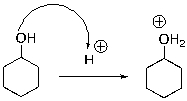
A) Proton transfer
B) Loss of leaving group
C) Nucleophilic attack
D) Rearrangement

A) Proton transfer
B) Loss of leaving group
C) Nucleophilic attack
D) Rearrangement

Unlock Deck
Unlock for access to all 110 flashcards in this deck.
Unlock Deck
k this deck
75
For the following reaction step, indicate which pattern of arrow pushing it represents. 
A) Proton transfer
B) Loss of leaving group
C) Nucleophilic attack
D) Rearrangement

A) Proton transfer
B) Loss of leaving group
C) Nucleophilic attack
D) Rearrangement

Unlock Deck
Unlock for access to all 110 flashcards in this deck.
Unlock Deck
k this deck
76
Which of the following mechanistic steps represents a nucleophilic attack?
A)
B)
C)
D)
A)

B)

C)

D)


Unlock Deck
Unlock for access to all 110 flashcards in this deck.
Unlock Deck
k this deck
77
The following reaction has three mechanistic steps. Draw all curved arrows necessary to complete the mechanism. 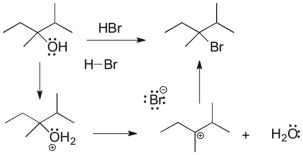


Unlock Deck
Unlock for access to all 110 flashcards in this deck.
Unlock Deck
k this deck
78
What is wrong with the following mechanism? 
A) There is no leaving group, so there should be no arrows.
B) The arrow should be removing a proton from the H2O group.
C) An arrow is also needed to indicate the loss of the leaving group.
D) The arrow is backwards.

A) There is no leaving group, so there should be no arrows.
B) The arrow should be removing a proton from the H2O group.
C) An arrow is also needed to indicate the loss of the leaving group.
D) The arrow is backwards.

Unlock Deck
Unlock for access to all 110 flashcards in this deck.
Unlock Deck
k this deck
79
Draw the structure of hydride.

Unlock Deck
Unlock for access to all 110 flashcards in this deck.
Unlock Deck
k this deck
80
For the following reaction step, indicate which pattern of arrow pushing it represents. 
A) Proton transfer
B) Loss of leaving group
C) Nucleophilic attack
D) Rearrangement

A) Proton transfer
B) Loss of leaving group
C) Nucleophilic attack
D) Rearrangement

Unlock Deck
Unlock for access to all 110 flashcards in this deck.
Unlock Deck
k this deck



